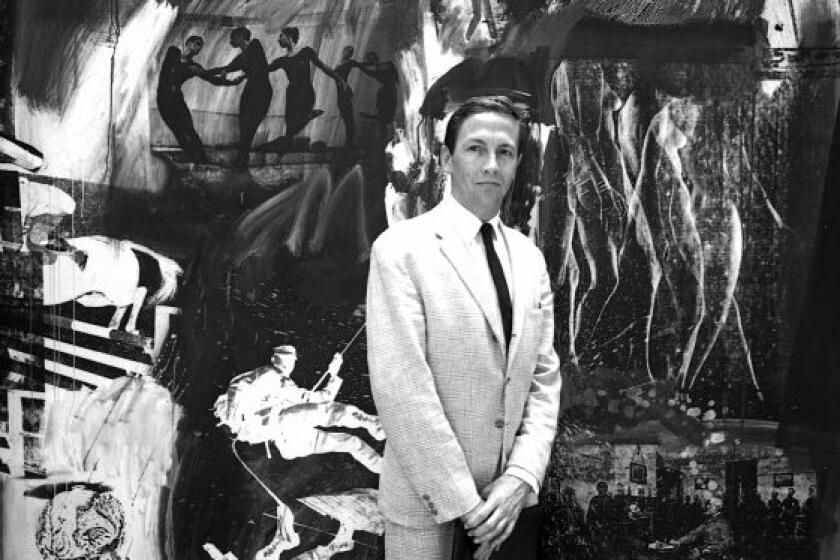Company Town : Cable Firms Poised for Turnaround : News analysis: Progress on digital delivery, possible easing of rate rules have industry upbeat.
The cable industry has suffered a few bruising years since Washington forced a rollback in consumer rates in 1992.
The telephone companies have decided to dive into the television business. The digital future has not developed as quickly--or been as heartily embraced by consumers--as was predicted, and Wall Street has shown little faith in the industry’s vision, driving down cable stocks and impeding financing of $40 billion in system upgrades.
But a turnaround may be near, according to some of the industry executives, analysts and bankers who convened this week in Dallas for the annual meeting of the National Cable Television Assn.
“We are bullish on cable,” said Christopher Dixon, a managing director at PaineWebber Inc., who named three leading cable providers, Tele-Communications Inc., Time Warner Inc. and Comcast Corp., among his favorite media stocks, despite their recent lack of popularity.
“A year ago, cable people were talking about the digital future, saying, ‘Trust me,’ but now they have a business strategy to send voice data and video into the home,” Dixon said after a financial session that was the best-attended at the four-day event. “There are actual alliances to do these things and there are servers’ modems and digital boxes from suppliers like Motorola and Microsoft on display here to support that effort.”
Indeed, since a year ago, one cable group has joined the Sprint long-distance carrier to build a national phone business. More recently, companies such as TCI have announced plans to offer fast, on-line services to customers who buy a high-priced modem to connect their cable boxes to their personal computers.
Dixon even ventured that Wall Street might finally be ready for cable operators to take on more debt to make critical investments--a musical note to executives preoccupied this year by what several referred to as a money crunch. In a presentation early in the week, Gerald Levin, the head of No. 2 cable operator Time Warner, seemed particularly on the defensive about Washington’s relentless regulation of the industry and Wall Street’s failure to understand the companies’ vision for a full-service network of interactive products.
“Why the Administration or the vice president continues to believe that the terribly challenging issue of rates being charged by cable companies is so important when there are so many critical issues is beyond me,” he said.
Perhaps more cause for optimism than the progress toward digital delivery--which the industry now admits is five to seven years away--is what some leaders view as a slight softening of the government’s harsh stance on rates in the face of a Republican Congress clamoring for deregulation.
In an attempt to break the industry’s monopolistic stronghold and amid its reputation for price gouging and poor service, the Federal Communications Commission in 1992 restricted rate hikes, causing the first decline in cash flow for the industry late last year and raising questions about how operators could finance investment. The rules and the fear of further regulations kept operators from upgrading their networks to compete with fast-growing satellite mini-dish broadcasters--which offer superior picture quality digitally--as well as the impending threat from phone consortiums such as Tele-TV.
The problems stifled new programming. Last year, 57 new channels ran aground for lack of space on cable networks. Even powerhouse cable broadcasters Turner Broadcasting has found the start-up of Turner Classic Movies slow going, with 4.9 million subscribers after one year, compared to TNT’s 17 million subscribers on the first day of its 1989 launch.
To give programmers relief, the FCC agreed last fall to allow cable operators to charge an additional 20 cents per channel for up to six new channels over two years.
The agency also seems to have tempered its hard line on rate hikes. It recently agreed to let Boston-based Continental Cablevision Inc., one of the largest cable systems, raise its prices to help offset a $9-billion investment in upgrades.
And last Friday, the FCC gave operators with fewer than 15,000 subscribers relief from rate regulations, a development that FCC Chairman Reed Hundt, speaking to conventioneers in Dallas, said reflects the new spirit of cooperation at the agency. “With the industry’s useful advice, we were able to make a change that will be very important to two-thirds of the cable operators in the country,” he said.
Still, while the new rules apply to the majority of the cable operators, they affect only 7 million of the total 64.2 million subscribers.
Another break for cable companies is what some industry watchers interpret as the uncertain steps telephone companies are taking into video. Stephanie Comfort, a telecommunications analyst at Morgan Stanley, said regional phone companies will push long-distance ahead of cable on their lists of new ventures.
Entering long-distance, she said, would cost little in capital investments while representing a $61-billion market, compared to cable’s $23 billion. “We expect an 18-month to two-year delay in their build-out,” she said. “And we are skeptical of what the Bells can do in programming.”
(BEGIN TEXT OF INFOBOX / INFOGRAPHIC)
Top 10 List
For its splashy announcement to Hollywood’s creative community this week that it was open for business, the telephone company joint venture Tele-TV showed a video of “Late Show” host David Letterman delivering a special Top 10 list.
Top 10 Ways a New Company Could Make Television Better
10. New Ed McMahon show: “Pants Search.”
9. If you see a beer commercial that you like, touch “3” on your remote control and an ice-cold six-pack magically appears.
8. Two words: Interactive “Baywatch.”
7. Hire some guy with a phony Welsh accent.
6. Pay-per-view event: Janet Reno wrestles a bear.
5. Remember that J.R. guy that got shot that time? Yeah, well bring that old coot back.
4. Put “Nightline” on the home shopping channel and let viewers buy Koppel’s toupee right off his head.
3. Picture-in-picture-in-picture-in-picture-in-picture.
2. Whatever Mr. Ovitz thinks will make TV better is what we think will make TV better.
1. Study everything CBS does; do opposite.
More to Read
The biggest entertainment stories
Get our big stories about Hollywood, film, television, music, arts, culture and more right in your inbox as soon as they publish.
You may occasionally receive promotional content from the Los Angeles Times.






